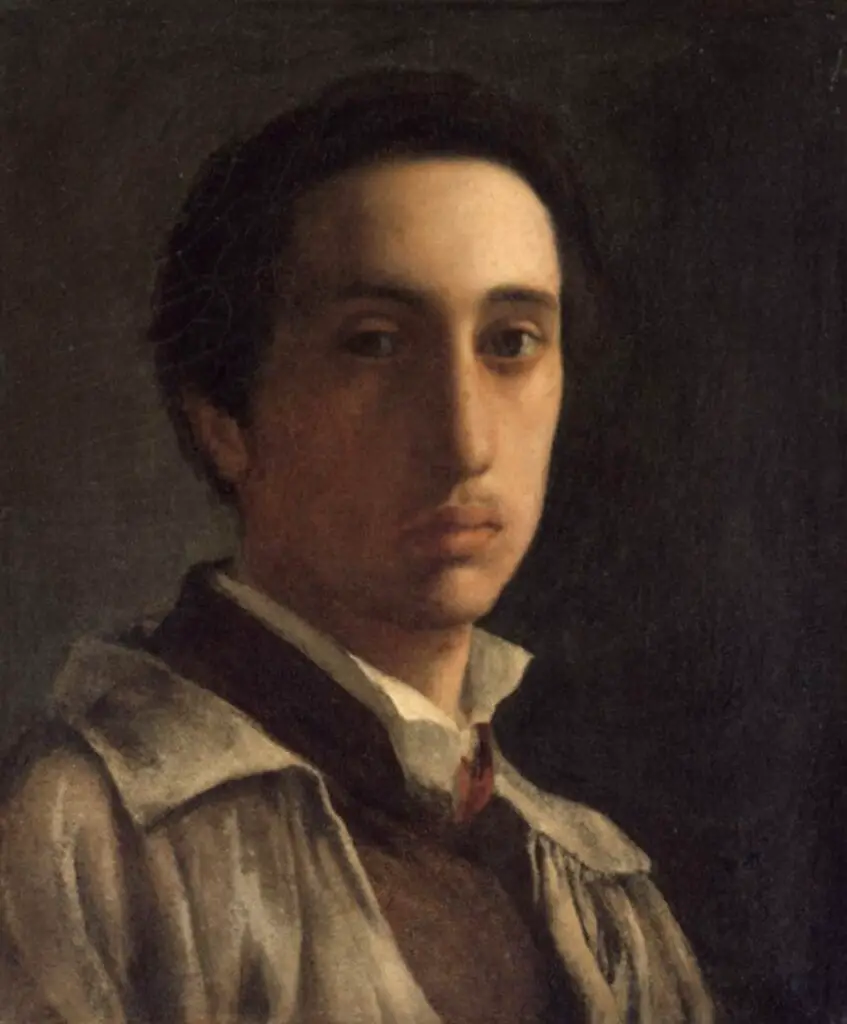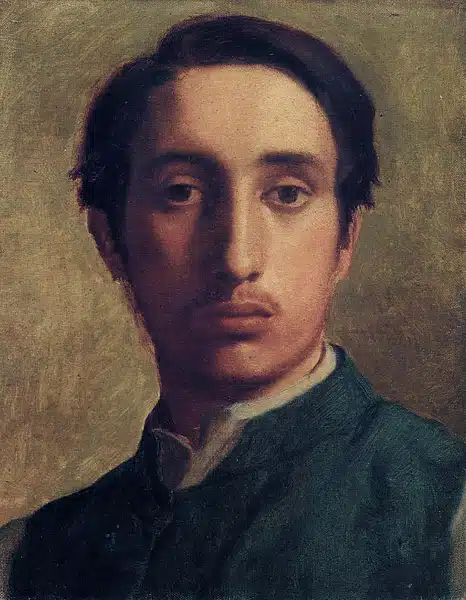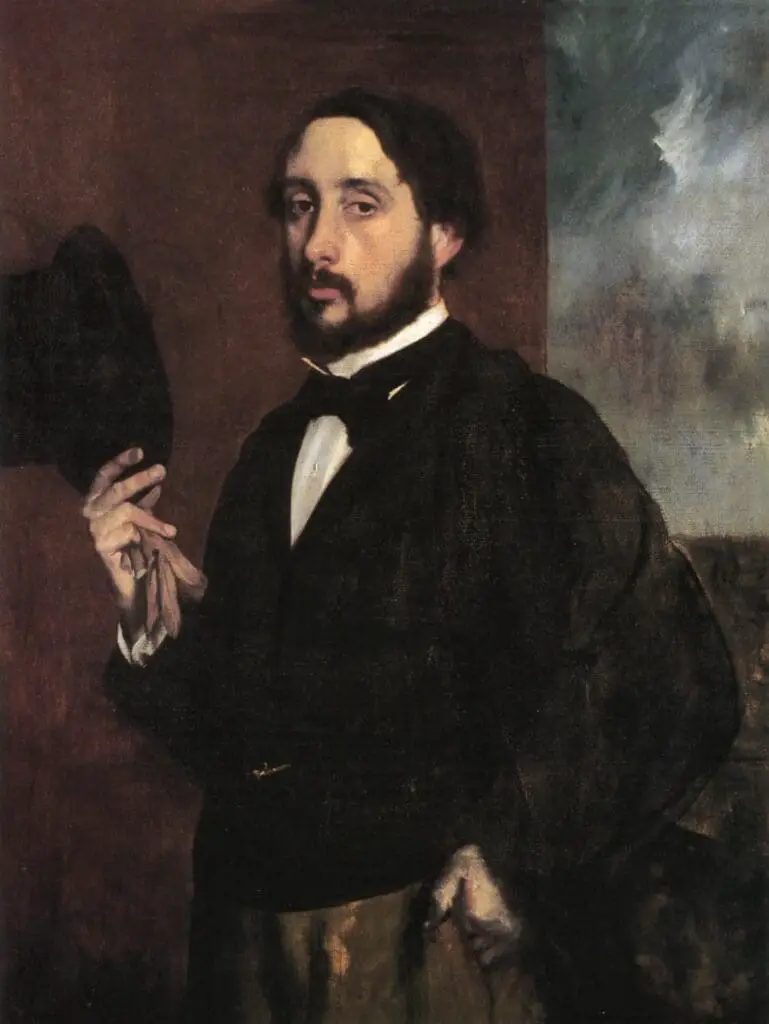Edgar Degas is often hailed as one of the greatest artists ever lived, renowned primarily for his enchanting paintings of ballet dancers. Yet there’s far more to this prodigious French artist than his dancers would suggest.
Edgar Degas was a prolific artist with a portfolio transcending the limited categories we often use to discuss his work. This comprehensive guide aims to delve into his fascinating life while answering 50 frequently asked questions about him.
Table of Contents
- Edgar Degas: The Master Of Movement And Everyday Moments
- 50 F.A.Q About The French Artist Edgar Degas
- Related Questions
Edgar Degas: The Master Of Movement And Everyday Moments
Edgar Degas, born in Paris in 1834, is often bundled together with the Impressionists; however, Degas himself would probably have disputed this categorization.

Despite the close association with iconic figures like Claude Monet and Pierre-Auguste Renoir, Degas had a unique style and favored subjects that set him apart from his contemporaries.
He traded the rolling landscapes and the ‘en plein air’ methods for intimate scenes of Parisian life, ballet dancers, and the entertainers of his time.
Edgar Degas – From Law To Art
Though born into a family with connections to banking and law, Degas had an early affinity for art that drew him away from a career in law, which he was initially expected to pursue.
His love for doodling and drawing was powerful enough to overcome societal and familial expectations, leading him to the École des Beaux-Arts in Paris.
Edgar Degas – Artistic Style And Media
Degas was a master of various mediums—oil paintings, pastels, and even sculpture. One thing that made his art distinctive was his use of unconventional angles and perspectives. Whether it was an acrobat performing high up in a circus tent or a ballet dancer in a candid backstage moment, his work captures life from unexpected yet profoundly revealing points of view.

In terms of materials, Degas often used pastels, which lend themselves well to capturing the ephemeral nature of moments. The pastels, which have a texture somewhat like chalk, allowed him to give his paintings a sense of immediacy and movement.
Edgar Degas – An Obsession With Movement
Degas was fascinated by human anatomy and movement. His drawings and paintings often showed an acute understanding of human physiology, as seen in the meticulous detail he employed to depict muscles and movement. This attention to detail made his representations of ballet dancers some of his most celebrated works. He didn’t just capture them in their graceful performances and most vulnerable moments—rehearsing, stretching, and waiting backstage.
Edgar Degas – Not Quite An Impressionist
Labeling Degas as an Impressionist is tempting because he was a contemporary of the movement’s leading figures and participated in their exhibitions. However, unlike the Impressionists, who often worked ‘en plein air’ to capture natural light and color, Degas argued for the importance of studio time to perfect a work of art.
His primary interest was in capturing the internal dynamics of everyday life, not the changing effects of light on a landscape.
Edgar Degas – A Diverse Portfolio
Beyond dancers and entertainers, Degas also created art featuring racehorses, women at their toilettes, and even some historical pieces. He had an eye for the less-often-seen facets of everyday life and made them the focal points of his artwork.
He also ventured into sculpture and even photography, always in pursuit of capturing the essence of movement and life.

Edgar Degas was more than just an artist; he keenly observed human life. He broke away from traditional subjects and styles, adopting methods that allowed him to capture fleeting moments with extraordinary vividness.
While he may not have considered himself an Impressionist, his impact on the world of art is as memorable as the strokes of pastel and oil in his captivating works. This capacity to convey grace, power, stillness, and motion makes Degas an enduring figure in art, cherished and studied even today.
50 F.A.Q About The French Artist Edgar Degas
1. Who was Edgar Degas?
Edgar Degas was a renowned French artist known for his contributions to Impressionism, particularly his paintings of ballet dancers.
2. When and where was Edgar Degas born?
Edgar Degas was born on July 19, 1834, in Paris, France.
3. What was Edgar Degas’s full name?
His full name was Hilaire-Germain-Edgar De Gas.
4. What is Edgar Degas most famous for?
Degas is most famous for his paintings and sculptures of ballet dancers.
5. Did Edgar Degas only paint ballet dancers?
No, while he is most famous for his ballet scenes, Degas also painted portraits, landscapes, horse races, and more.
6. Was Edgar Degas an Impressionist artist?
Yes, Edgar Degas was associated with the Impressionist movement, although he preferred to call himself a “realist.”
7. Who were some of Edgar Degas’s contemporaries in the art world?
Some of his contemporaries included Claude Monet, Pierre-Auguste Renoir, and Camille Pissarro.
8. What was Edgar Degas’s style of painting known for?
Degas’s style was known for its focus on capturing everyday life, use of color and light, and his interest in the human form.
9. How many ballet dancer paintings did Edgar Degas create?
He created over 1,500 paintings, drawings, and sculptures related to ballet dancers.
10. What inspired Edgar Degas to paint ballet dancers?
Degas was inspired by his visits to the Paris Opera and his fascination with the grace and movement of dancers.
11. Did Edgar Degas paint male ballet dancers as well?
Yes, he painted both male and female ballet dancers.
12. What is the significance of Degas’s paintings of dancers in tutus?
Degas’s tutu-clad dancers often symbolize the blend of art and reality, capturing the fleeting moments of grace on stage.
13. How did Edgar Degas use pastels in his art?
Degas was known for his skillful use of pastels, creating vibrant and textured works with this medium.
14. Did Degas have formal art training?
Yes, he studied at the École des Beaux-Arts in Paris, where he received a classical art education.
15. Was Edgar Degas a successful artist during his lifetime?
While he faced financial struggles early in his career, Degas gained recognition and success later in life.
16. Did Edgar Degas ever get married?
No, Degas never married and remained a lifelong bachelor.
17. How did Edgar Degas die?
Edgar Degas died on September 27, 1917, in Paris, at the age of 83.
18. Where are some of Degas’s most famous works displayed today?
His works are displayed in major museums worldwide, including the Louvre, the Musée d’Orsay, and the Metropolitan Museum of Art.
19. Did Degas have any close artist friendships?
He had a close friendship with fellow artist Mary Cassatt, and they often influenced each other’s work.
20. What is Edgar Degas’s legacy in the art world?
Degas’s legacy lies in his contributions to Impressionism and his unique portrayal of modern life in 19th-century France.
21. Did Edgar Degas create any sculptures?
Yes, he created sculptures, with “The Little Dancer of Fourteen Years” being one of his most famous sculptural works.
22. How did Degas approach his sculpture work?
Degas’s sculptures were typically based on his observations of real-life dancers, capturing their natural poses and movements.
23. Did Edgar Degas have any preferred models for his artworks?
Many of his ballet dancer paintings featured a young dancer named Marie van Goethem.
24. What were some of Degas’s favorite colors to use in his art?
He often used soft pastel colors and shades of pink, which were common in his ballet dancer paintings.
25. How did Degas’s art evolve over his career?
His early works were more traditional, but he later developed a more experimental and innovative style.
26. Did Edgar Degas face any criticism for his art during his lifetime?
Yes, some critics were initially harsh towards his work, but he gained acceptance over time.
27. How did Degas depict movement in his paintings?
Degas used techniques like blurring and unconventional compositions to convey the dynamism of his subjects.
28. What is “The Absinthe Drinker,” and why is it significant?
“The Absinthe Drinker” is a notable Degas painting, symbolizing the social issues of his time, particularly alcoholism.
29. What was Degas’s relationship with photography?
Degas was interested in photography and occasionally used it as a reference for his artwork.
30. Did Degas travel extensively during his lifetime?
He traveled to Italy, New Orleans, and other places, but Paris remained his primary base.
31. How did Degas’s eyesight deteriorate over time?
Degas suffered from vision problems later in life, which affected his ability to create art.
32. What is the significance of Edgar Degas’s “L’Absinthe” painting?
“L’Absinthe” portrays the isolation and alienation of urban life in the late 19th century.
33. Did Edgar Degas have any formal art exhibitions during his lifetime?
Yes, he participated in several Impressionist exhibitions in Paris.
34. How did Degas’s family feel about his career as an artist?
His family was initially supportive, although they had concerns about his financial stability.
35. Did Edgar Degas have any notable patrons?
He had several patrons, including art collectors and dealers who supported his work.
36. What is the significance of Degas’s use of mirrors in his art?
Mirrors often appear in his artwork, reflecting his interest in capturing multiple perspectives and angles.
37. Did Degas create any self-portraits?
Yes, he created a few self-portraits throughout his career.
38. How did Degas’s work influence later artists?
Degas’s innovative techniques and subject matter influenced artists like Picasso and Matisse.
39. What are some famous quotes by Edgar Degas about art?
“Art is not what you see, but what you make others see” is a famous Degas quote.
40. How did Degas’s personal life impact his art?
His introverted and observant nature played a significant role in his unique portrayal of subjects.
41. What is the “Degas Circle,” and who were its members?
The Degas Circle refers to his close artist friends, including Mary Cassatt and Édouard Manet.
42. Did Edgar Degas receive any awards or honors during his lifetime?
Yes, he received several awards and accolades for his contributions to the arts.
43. How did Degas’s health decline in his later years?
His health deteriorated, with eye problems, depression, and mobility issues affecting his life and art.
44. What is the controversy surrounding some of Degas’s works in Nazi possession?
Some of Degas’s artworks were looted by the Nazis during World War II, leading to disputes over their ownership.
45. How have Degas’s works been preserved and restored over time?
Conservators have employed various techniques to preserve and restore Degas’s delicate pastel works.
46. Are there any lost or missing works by Edgar Degas?
Some of his works remain lost or unaccounted for, adding to the mystery of his art.
47. What is the most expensive Edgar Degas artwork sold at auction?
“Danseuse au Repos” (A Dancer Resting) holds the record, selling for over $37 million.
48. How has Degas’s art been celebrated in popular culture?
His art has been featured in films, literature, and even ballet performances.
49. How can one distinguish an authentic Degas artwork from a fake?
Authenticity is often determined by provenance, expert analysis, and documentation.
50. What should art enthusiasts know about appreciating Edgar Degas’s work today?
To appreciate Degas’s work fully, one should explore his diverse portfolio, understand the historical context, and visit museums to view his masterpieces up close.
Anita Louise Art is dedicated to art education, great artists, and inspiring others to find and create their art. We love art that uplifts and inspires. #ArtToMakeYouSmile! #ArtToMakeYouHappy!
If you want to see any of my art, you can find out more by clicking here. If you are interested in what inspires me and my paintings, you can discover more by clicking here.
We have a free newsletter and would love you to be part of our community; you can subscribe to the newsletter by clicking here. I would be happy to talk to you if you have any questions. You can reach me, Anita, by clicking here.
Subscribe to our Anita Louise Art YouTube Channel with great videos and information by clicking here.
Join us for our podcast “5 Minutes With Art.” Spend just 5 minutes a week with us to discover and learn about great art and artists. You can find out more about our podcast by clicking here.
Related Questions
What Was The Focus Of Renaissance Art?
The focus of Renaissance art was on the classics of Greek and Rome, humanist philosophy, and the study of the human figure. Realism was also an essential part of renaissance art. The great artists of the Renaissance also became great anatomists and studied human beings.
By clicking here, you can learn more by reading What Was The Focus Of Renaissance Art?.
What Is The Importance Of Art From The Renaissance Period?
Renaissance art is essential as it was a time of rebirth and discovery. Artists like Leonardo da Vinci, Michelangelo, and Raphael were at the forefront of that change, creation, and discovery. Renaissance art has influenced art and artists for many centuries and continues to influence artists today.
By clicking here, you can learn more by reading What Is The Importance Of Art From The Renaissance Period?.
Early Renaissance Vs. High Renaissance Art Explained
Early Renaissance and High Renaissance are both periods of the art of the Renaissance era. The entire Renaissance era shared a lot of the same characteristics. The High Renaissance was dominated by three major artists: Leonardo da Vinci, Michelangelo, and Raphael.
By clicking here, you can learn more by reading Early Renaissance Vs. High Renaissance Art Explained.


